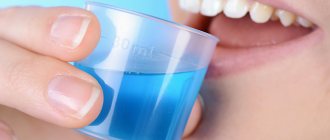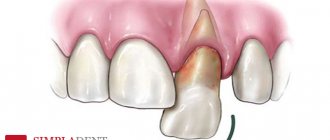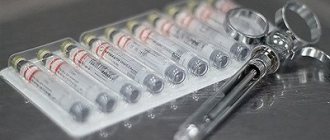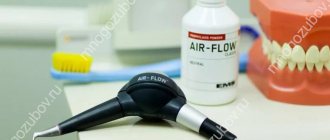- How peroxides whiten dentin
- Hydrogen peroxide
- Urea peroxide
- Where are peroxides found?
- Side effects
Sometimes, to restore whiteness to teeth, you can just remove pigmented plaque from the enamel. If this is not enough, and you are not satisfied with the result, you need to change the natural color of your teeth. This requires dentin bleaching. The fact is that the enamel itself is translucent, and the color of teeth mainly depends on the color of dentin - the hard tissue of the tooth that makes up its main part.
Professional and home whitening products widely use hydrogen and carbamide peroxides. Peroxides are complex substances in which oxygen atoms are connected to each other by single bonds (in other substances by double bonds). Such a connection is easier to break. In addition, in peroxides, oxygen has an oxidation state of “-1” instead of “-2” - that is, it is active during elimination.
How peroxides whiten dentin
Hydrogen peroxide
Hydrogen peroxide molecules easily penetrate the enamel, releasing active oxygen and oxidizing pigmented dentin. It brightens and, shining through the enamel, makes teeth visually whiter.
Urea peroxide
Carbamide peroxide whitens teeth according to the same principle: when it breaks down, hydrogen peroxide is formed, which gives the desired effect. But the reaction rate of carbamide peroxide is lower. Therefore, the impact on the teeth should be longer. However, the mucous membrane is less irritated. If you have sensitive gums, choose products with carbamide peroxide.
Is it possible to whiten teeth with hydrogen peroxide?
With age, every person's tooth enamel becomes thinner and becomes covered with roughness that is invisible to the naked eye.
As a result of smoking, regular consumption of food containing dyes, as well as drinking coffee and tea, a kind of pigmented film is formed on the surface of the teeth, tightly attached to the rough surface of the teeth. It is impossible to remove it with even the most expensive paste, so to restore a beautiful smile, it is necessary to periodically carry out the whitening procedure. In order not to harm the enamel, it is better to entrust such a procedure to specialists. However, if this is not possible, you can resort to gentle remedies at home.
When the need arises to whiten teeth at home, many people use hydrogen peroxide. This product really works as an effective bleach and can eliminate yellow plaque, age spots and darkening.
Dentist on the advantages and disadvantages of teeth whitening with peroxide:
Operating principle
Penetrating into the enamel and dentin of the tooth, the drug reacts with dental tissues, releasing oxygen, which causes organic substances to break down into simpler compounds. Thus, oxygen helps remove plaque.
Sometimes peroxide is used as an antiseptic - for colds, it is used to gargle. For such rinses, a weakly concentrated solution is used, which does not affect the enamel, but also does not have a whitening effect.
Where are peroxides found?
Carbamide peroxide and hydrogen peroxide are found in popular whitening products:
- in whitening strips;
- in gels for use with mouth guards;
- in applicator pencils;
- in some toothpastes.
When choosing a product, pay attention to the concentration of peroxides. From 10% carbamide peroxide, when it decomposes, 3% hydrogen peroxide is released, therefore the concentration of carbamide peroxide in the bleaching product is always higher. Roughly speaking, a gel with 10% carbamide peroxide is as effective as a gel with 3% hydrogen peroxide.
Whitening at home
There are quite a few different ways to lighten teeth with peroxide, and they all have a good effect.
Important! Only 3% peroxide is allowed to be used, since more concentrated solutions will inevitably lead to damage to the enamel.
Peroxide rinse
Rinsing with pure peroxide is one of the simplest methods, so it is recommended for people who are limited in time.
Thus, the rinsing procedure takes no more than 5-10 seconds, which is very convenient if you are in a hurry to work in the morning and do not have the opportunity to spend time preparing the compositions. You should not keep the product in your mouth for more than 10 seconds - this will help minimize the risk of damage to the enamel. During the procedure, tingling and some burning may occur - this is absolutely normal, so there is no need to worry. After rinsing, you need to moisten a cotton swab in the preparation and gently wipe the problem areas.
Then rinse your mouth with warm water and refrain from eating or drinking anything for at least 30 minutes.
For prevention purposes, this method is recommended to be used once a week. If you need to lighten your teeth and remove pigment plaque, rinse your mouth once a day. As a rule, this procedure works quickly and the effect becomes noticeable after 2-3 weeks.
Brushing with a toothbrush
This method also does not take much time and effort.
Whitening is carried out in three stages:
- First, brush your teeth with a toothpaste that contains fluoride.
- Then mix warm water and peroxide in equal proportions in a glass and, dipping the brush into the glass, brush your teeth for 1 minute.
- Rinse your mouth and refrain from eating or drinking anything for the next 30 minutes after the procedure.
Soda mixture
Baking soda is an excellent bleaching agent.
There are recipes for teeth whitening using only soda. When used in combination with peroxide, you will get maximum benefit and visible results. The process itself is performed as follows:
- First of all, prepare a thick paste from peroxide and soda.
- Then apply it to the surface of your teeth. You can use a cotton swab or your fingers to do this.
- Leave the mixture on your teeth for 3 minutes, then rinse your mouth with warm water.
- Afterwards, brush your teeth using fluoride toothpaste.
When using soda and peroxide, it is important to adhere to the following rules :
- Do not use a toothbrush, especially one with hard bristles, to apply the mixture.
- Avoid contact of the mixture with mucous membranes and gums.
- Do not allow the mixture to come into contact with your teeth for more than 3 minutes.
A blogger tries to whiten teeth using a similar recipe:
With water
The whitening process consists of three stages:
- Brushing teeth using fluoride toothpaste. It has a protective effect on the enamel and prevents it from damage.
- Next, you will need to prepare a rinse. For this purpose, mix peroxide with boiled water in equal proportions. Rinse duration is one minute.
- Finally, rinse your mouth with plain water, which will wash away any remaining medication. It is not recommended to consume food or drinks for 30 minutes after the procedure.
With pasta
In a small container, mix peroxide and toothpaste in equal proportions and use the resulting mixture in the morning to brush your teeth.
Soda and salt solution
To properly prepare the solution, you will need :
- 1 part peroxide.
- 2 parts water.
- A pinch of salt.
- A pinch of soda.
Rinse your mouth with the resulting solution for 1 minute.
With tooth powder
Dip the brush in tooth powder and gently apply 2-3 drops of peroxide on top. After this, you need to brush your teeth as usual and rinse your mouth with water.
Soda, hydrogen peroxide, lemon
Prepare a paste of 2-3 drops of lemon juice, peroxide and soda. Apply the mixture to a soft toothbrush and gently brush your teeth.
Video on the topic:
Side effects
Products containing hydrogen peroxide and carbamide peroxide may cause side effects:
- weakening of tooth enamel;
- increased tooth sensitivity;
- irritation of the gum mucosa.
If you use whitening products strictly following the instructions and take care to strengthen the enamel, the risk of side effects is minimal.
Important
. Do not use pharmaceutical peroxide in bottles for whitening - it will leave burns on the mucous membrane and damage the enamel. Use only professional, balanced products - as a rule, they have passed many tests and are safe for the oral cavity.
Preparing your teeth
Since the whitening procedure is quite harmful to tooth enamel, before starting it, measures should be taken to minimize the likelihood of negative consequences.
First of all, visit a dentist who will determine the condition of your teeth and enamel. Any manipulations using peroxide can only be carried out by those people who have thick and fairly durable enamel.
The dentist will examine the teeth, identify areas with darkening and yellowing and determine the nature of their origin. If the yellowness is not outside, but inside the tooth, then peroxide will not give the expected whitening result.
Reviews from doctors and patients
- Lyudmila B: Recently I had an urgent need to whiten my teeth. I didn’t have time to go to the dentist, so I decided to try a recipe with peroxide, salt and soda. I didn’t expect that simple home remedies could completely clean and improve the appearance of teeth in just one go. However, I want to warn you: I decided to take a 7-day course, and already on the fifth day my teeth became very sensitive to cold and hot foods.
- Dmitry K: A friend recommended the method of teeth whitening using peroxide. The fact is that I am a heavy smoker, and, accordingly, the color of my teeth leaves much to be desired. The result pleased me: a week after brushing with toothpaste enriched with peroxide, my teeth became noticeably lighter.
- Irina, dentist: For some people, yellowish or grayish teeth are their natural color. And when trying to whiten such teeth, you can cause irreparable harm to their health. In addition, there are a number of contraindications for the use of peroxide, neglect of which also leads to disastrous results. Therefore, I recommend that my patients carry out the whitening procedure only in dental clinics, where special gentle products and professional equipment are used.
Precautionary measures
- Before using peroxide, you need to do a sensitivity test by applying the product to the inside of the elbow.
- Peroxide is a very strong oxidizing agent. It can not only lighten teeth, but also increase their sensitivity. Therefore, people who experience discomfort or painful sensations on their teeth while eating hot or very cold food should avoid using this product.
- Also, people with periodontal disease, caries and teething wisdom teeth should not use this product.
- Peroxide should not be used by children under 12 years of age, since their tooth enamel is still developing and is not very dense. Pregnant women and people who wear braces or crowns should avoid using peroxide as a teeth whitener.
Reference! You can use peroxide for teeth whitening no more often than 1 course, consisting of 2-3 weeks, every 2-3 months.
Hydrogen peroxide - what is the substance
Peroxide or hydrogen peroxide is a colorless liquid with a faint metallic taste. The substance itself is widely used as an effective antiseptic. Its molecules destroy pathogenic microflora and suppress the proliferation of harmful microorganisms.
Hydrogen peroxide softens dental plaque
This is interesting! The solution has found wide application, including in aquarium farming. In this area it is used to “revive” fish. The fact is that prolonged transportation, overheating of the aquarium or turning off filtration leads to oxygen starvation of its inhabitants. To bring fish back to life, a small amount of peroxide is added to the water.
The liquid also has oxidizing properties, so it is used as a bleach in the pulp, paper and textile industries, and also as a catalyst in the chemical industry. A solution in high concentration can cause serious burns to the mucous membranes and respiratory tract, which seriously prohibits any attempts to take it orally.
General information
About peroxide
Only a few of the possible ways to use peroxide were listed. However, peroxide is most often used in the household, for example, it effectively whitens laundry. This method is very affordable and economical for returning things to their former freshness and snow-whiteness.
Hydrogen peroxide. This drug has many useful qualities.
It is often used in medicine as a means to disinfect wounds, although it can also be used in other cases, such as:
— treatment of diseases of the ears and oral cavity;
— getting rid of mold and fungal infections;
- getting rid of skin blemishes;
— teeth whitening;
- hair lightening, etc.
Pros and cons of this type of whitening
Hydrogen peroxide is universal; it is suitable for bleaching all fabrics. You can purchase this product at any pharmacy. Textile fibers are not damaged by such fabric bleaching. This method can also be used to bleach delicate items made of wool or silk. To bleach fabrics, you can only use a 3% peroxide solution, which is made by mixing 2 tbsp. ammonia and peroxide solution and 10 liters of water. Items that need to be bleached are soaked in the prepared solution for half an hour and then washed as usual.
REFERENCE! You can return things to their original appearance, which turns gray and fades with constant wear and frequent washing, using this method. It gets rid of traces of sweat, vegetable oil, and antiperspirant.
Pros of bleaching things with peroxide:
- Low cost.
- Peroxide even removes old stains.
- The whitening solution is very easy to prepare.
- Economical consumption.
- The material is preserved in its original form.
The whitening effect is achieved through the direct action of peroxide on stains, while it saturates the material with oxygen and breaks down dirt.
An analogue of peroxide is hydroperite in tablets. Instead of one spoon of peroxide, you will need one tablet of hydroperite. The action of these drugs is the same, but hydroperite differs in the presence of urea in the composition.
How safe is peroxide for teeth?
Proper use of hydrogen peroxide gives good results. But the product should not be abused, because otherwise its frequent use can cause serious harm to the condition of dental tissues:
- hypersensitivity (hyperesthesia): in such cases, an acute painful reaction occurs to any temperature changes in food and drinks, to chemical and mechanical irritants. The main reason is the thinning of the enamel, the partial loss of its protective functions. To prevent this phenomenon, experts recommend using fluoride-containing oral care products or taking a course of fluoridation,
Abuse of the drug can cause tooth sensitivity
“I tried to whiten my teeth with lemon. As a result, I became so sensitive that I could not drink tea or cold drinks. Then I had to fluoride the enamel at the dentist and restore it. The next time, but this was a year later, I tried peroxide. A week later there was an effect, but it was quite insignificant. Thank God the sensitivity did not return. I didn’t experiment anymore...”
RitaSemena_89, from correspondence on the forum www.32top.ru
- coated teeth: the problem occurs after prolonged exposure to soda and peroxide on the tissue. In this case, the upper shiny layer is partially erased, revealing chalky matte areas - the problem can only be solved in dentistry,
- demineralization - the appearance of small whitish spots indicates the beginning of the process of loss of minerals, which leads to the gradual destruction of hard tissues.
If the solution is used incorrectly, it can lead to irritation and even burns of the mucous membrane. If negative reactions occur after whitening, it is better to see a dentist.
What do they say about this method?
Many people use this method to achieve whiter teeth at home. Most of them who adhere to the recommendations get the desired effect.
If you are familiar with the methods described, you can provide feedback by adding a comment to this article.
Well, what do dentists say about home enamel whitening techniques? Let’s watch the following video:
If you find an error, please select a piece of text and press Ctrl+Enter.
Tags teeth whitening hydrogen peroxide
Did you like the article? stay tuned
Previous article
Oral sanitation: what is it, how is it done, cost
Next article
Tea tree oil for home teeth whitening
Preparing for washing
To ensure that the laundry becomes white and all stains are removed from the fabric, you need to prepare things for washing. It is better to do this by soaking them first. Pour warm water into a wide basin, add washing powder, bleach (if the fabric allows) and place the laundry. Leave the items to soak for 4-5 hours, and then proceed to washing.
If you plan to use a certain bleaching product, do not be lazy and test its effect on an inconspicuous area or a separate piece of the same fabric so as not to spoil the laundry.
What do dentists say about this?
Experts do not express strong protests against the use of peroxide for preventive purposes. In professional whitening, this is an indispensable component, but there it is used in high concentrations and under the strict supervision of specialists. But at home, using a weak solution can provide more effective plaque removal. An oxidation reaction occurs on the surface of the enamel, due to which the compounds that form bacterial plaque are destroyed.
The photo shows the procedure for professional oral hygiene
Only if, as part of professional whitening, a specialist additionally treats dental tissues with fluoridated paste and gel polish, then it is not possible to provide such prevention at home. Therefore, doctors often advise purchasing fluoride paste during a home whitening course, but only after consulting with your dentist.
Details
Hydrogen peroxide use for bleaching laundry
It is used in the following cases:
- when you need to restore color;
— eliminate yellow spots on silk or wool products;
- remove sweat stains.
To restore the color of a grayed item, you need to pour hot water into a basin and add peroxide and ammonia. Consumption - 2 tbsp. each product for 10 liters of water. The product should be left in this liquid for about half an hour and then washed as usual.
To return snow-white to delicate fabrics, you will need to mix:
- 1/2 bucket of water;
- 1 tbsp. l. peroxides;
- 1 tbsp. ammonia solution;
- 4 tbsp. coarse salts;
- 1 tbsp. powder for washing white fabrics.
All ingredients must be thoroughly mixed and the laundry soaked for 2-3 hours.
To whiten yellow stains from cotton, apply a 3% peroxide solution to the stains and wait 5 minutes.
REFERENCE! If stains remain after drying, the procedure can be repeated.
The most popular methods and additions to peroxide
There are many different options for using peroxide to whiten things. Each of them is designed for specific types of fabrics. When choosing a bleaching method, you need to correctly recognize the material from which the item is made, as well as select the washing mode and water heating temperature.
natural fabrics with hydrogen peroxide
To bleach natural fabrics, you can use a gentle method using baking soda. To restore color, you need to mix 5 liters of water, 5 tbsp. soda and 2 tbsp. ammonia solution. To begin with, you need to put your laundry in this liquid for 4 hours and then wash them.
To bleach cotton or linen, you will need soda ash, which should be poured into the washing machine along with the powder. The washing temperature should be set to 70 0C.
REFERENCE! Before bleaching laundry using aggressive methods, you should try to clean the item with a simple product - soda paste. It is easy to prepare - just dissolve a little baking soda in water. This paste must be applied to the stain, gently rubbing it into the fabric. Then you need to wait half an hour, after which you wash the item. If the item is not completely cleaned, the procedure should be repeated.
Baking soda and hydrogen peroxide for whitening clothes
To whiten collars and cuffs of shirts, you will need a mixture of 1 tsp. soda and 10 ml of hydrogen peroxide. This mixture should be applied to the stains and left to act. After 15 minutes, the mixture must be washed off, the shirt washed and rinsed well.
The down scarf will turn white again if you have vinegar, hydrosulfite and nylon thread. You need to take 10 liters of water and add 2 tbsp to it. hydrosulfite. The scarf should be placed in a basin and left for 20 minutes. There is no need to rub or pull. You need to wash the scarf by hand, without using dry cleaning, as this harms the product and greatly reduces the wear period of the down scarf. After this, the product must be rinsed in warm and cold water, to which 2 tablespoons have been added. vinegar. Then the scarf must be wrung out and hung on a line to dry.
synthetic fabrics with hydrogen peroxide
Items made from synthetic fabrics such as tulle, underwear and other clothing are bleached at low water temperatures. For such fabrics, products containing chlorine cannot be used. It is also impossible to dry such things in direct sunlight. Polyester items can be bleached with salt - 600 g of coarse salt is needed for 10 liters of water. You need to leave things in this solution for a while (about two hours), then rinse.
Another method is a solution with the addition of soda and ammonia. It is prepared based on 10 liters of water:
- 10 tbsp. soda;
- 2 tbsp. ammonia.
Things should be left in this solution for 3 hours.
Remove stains from denim with lemon juice. For 1 liter of water you will need 1 tbsp. lemon juice and 1 tsp. citric acid. Jeans are soaked in this solution and rinsed, then dried. This product can be applied with a spray bottle to lighten some areas of the pant leg.
A good way to bleach all types of fabrics is laundry soap. Contaminants should be washed off and the items should be put into a bag, carefully packed in a plastic bag. So things need to be left for a day, and then taken out and rinsed.
REFERENCE! Hand washing and soaking items in hydrogen peroxide can help remove various stains. To get rid of unpleasant peroxide odors, products can be washed with scented powder.
Effect of use
The effect of lightening the color of teeth by 1-2 shades will occur already 2-3 weeks after the start of the procedures. To prevent repeated darkening of the enamel, it is advisable to repeat the procedure at least 2-3 times a year.
Possible negative consequences
When using peroxide, you need to be careful not to harm your dental health. Thus, an incorrectly performed procedure can cause bleeding gums as a result of a chemical burn.
If you have a filling, you should take into account that if it does not fit tightly, peroxide can penetrate inside the tooth, which will lead to accelerated destruction.
Experiment using peroxide for whitening:
The principle of operation of the solution
In addition to its disinfecting properties, hydrogen peroxide has a whitening effect and the ability to suppress the production of melanin in the body. It is used to bleach hair, and when molecules of the substance enter the structure of the fibers, a certain reaction occurs with the participation of amino acids, as a result of which the hair changes shade. But attempts to lighten the skin in this way will be ineffective. Peroxide molecules are not able to penetrate into the deep layers of the epidermis containing melanin. It’s the same story with teeth whitening – the substance itself is not capable of causing a change in the color of the enamel from the inside.
Continuing the topic of whether a solution whitens teeth, it is important to note that peroxide is included in most professional whitening gels. Specialists in the field of aesthetic dentistry usually use products with a concentration of 45 to 60%. In addition, such preparations necessarily include additional softening components - potassium, glycerin and fluorine1. As part of the procedure, the doctor must reliably isolate the mucous membrane, since contact with the active substance on it can easily lead to a burn. To activate the active components, various catalysts are used, including UV radiation or laser.
In pharmacies, peroxide is sold in concentrations from 3 to 6%. This is too little to achieve noticeable results at home. But since the substance has antiseptic properties and copes well with surface stains, it can be used to better remove plaque and age spots, that is, to restore the natural whiteness of teeth. You just need to do this carefully, taking all precautions and only after consulting a dentist.
In pharmacies, peroxide is sold in concentrations from 3 to 6
How does it work?
Photo: patient’s enamel before (left) and after (right) using peroxide for lightening
Anyone can buy a solution of hydrogen peroxide at a regular pharmacy for a completely insignificant amount. It looks like a completely transparent liquid with no color. Its chemical formula is H2O2. Initially, it is needed to carry out the initial treatment of various skin lesions.
However, the properties of this compound suggest that it can also be used as a good bleach, which is often used at home. The fact is that peroxide is an excellent oxidizing agent
.
The chemical oxidation reaction that occurs when it comes into contact with the surface of the teeth causes the compound to break down into individual components and substances.
In the case of the product in question, so-called active oxygen is released
, which can act not only on the surface, but also in the inner layers of enamel close to it. It is this element that has the ability to break down organic substances that make teeth darker into ordinary water with carbon dioxide.
It should be noted that most medications intended for whitening contain hydrogen peroxide. These products include not only special pastes, but also complete systems for home whitening, available in the form of gels, trays or special strips.
In addition, professional techniques used in modern dental clinics involve the use of special preparations, which also include this chemical compound. However, nowhere is peroxide used on its own, only as part of preparations with many different additives.











